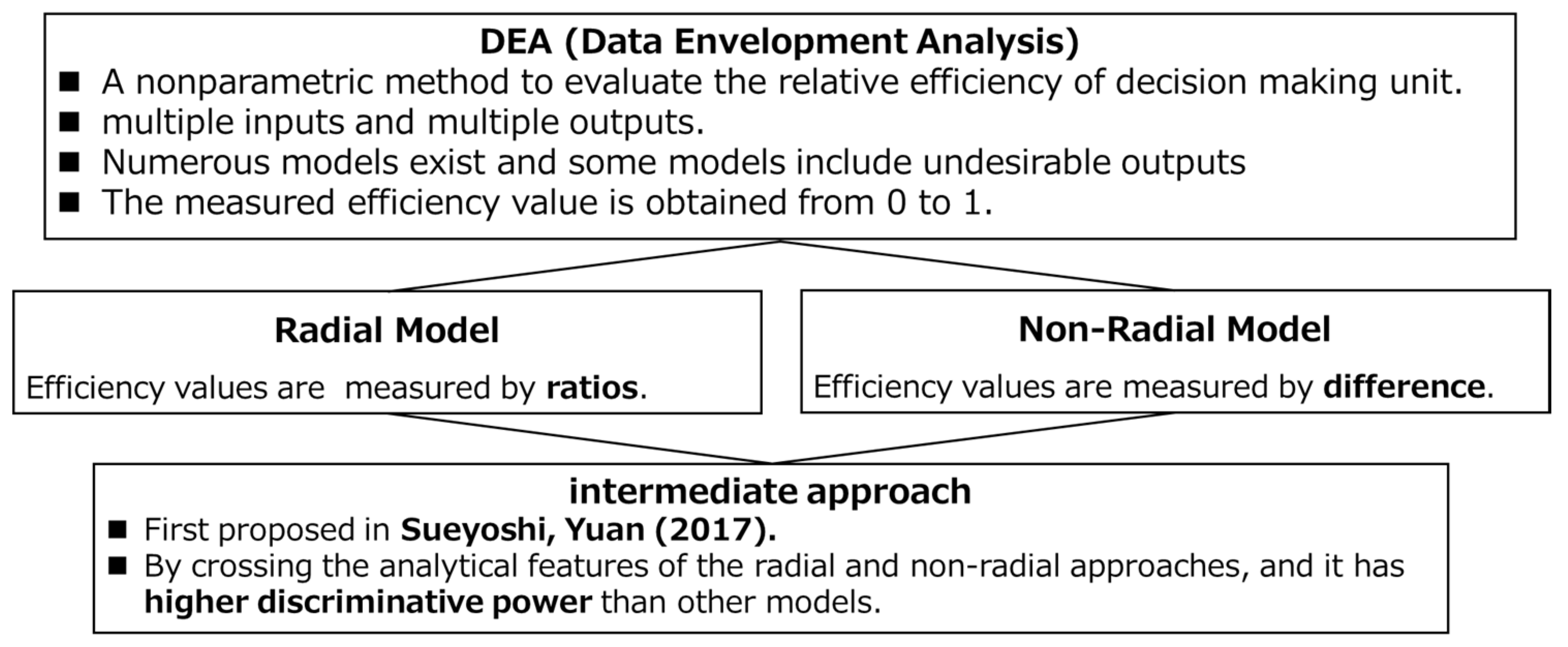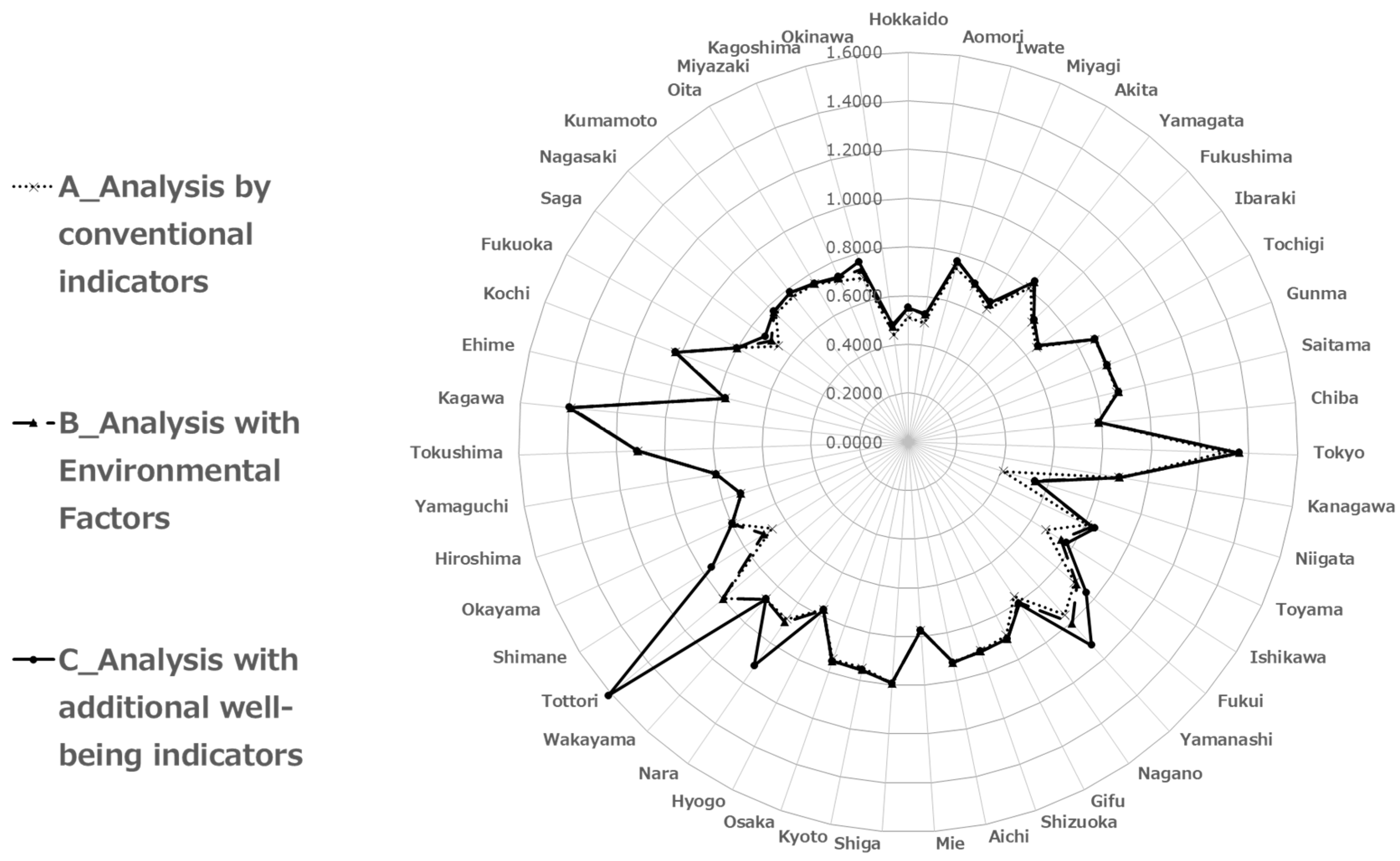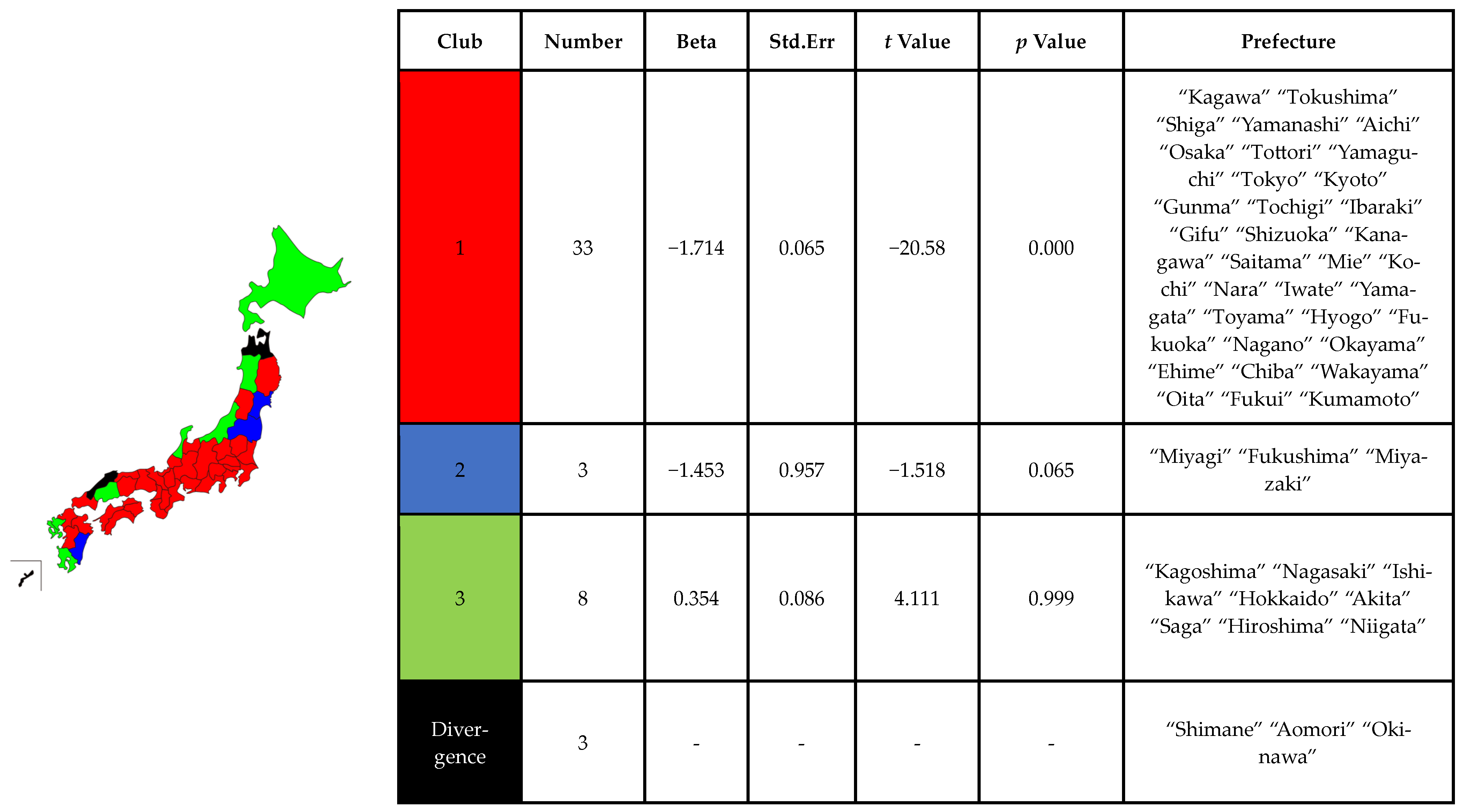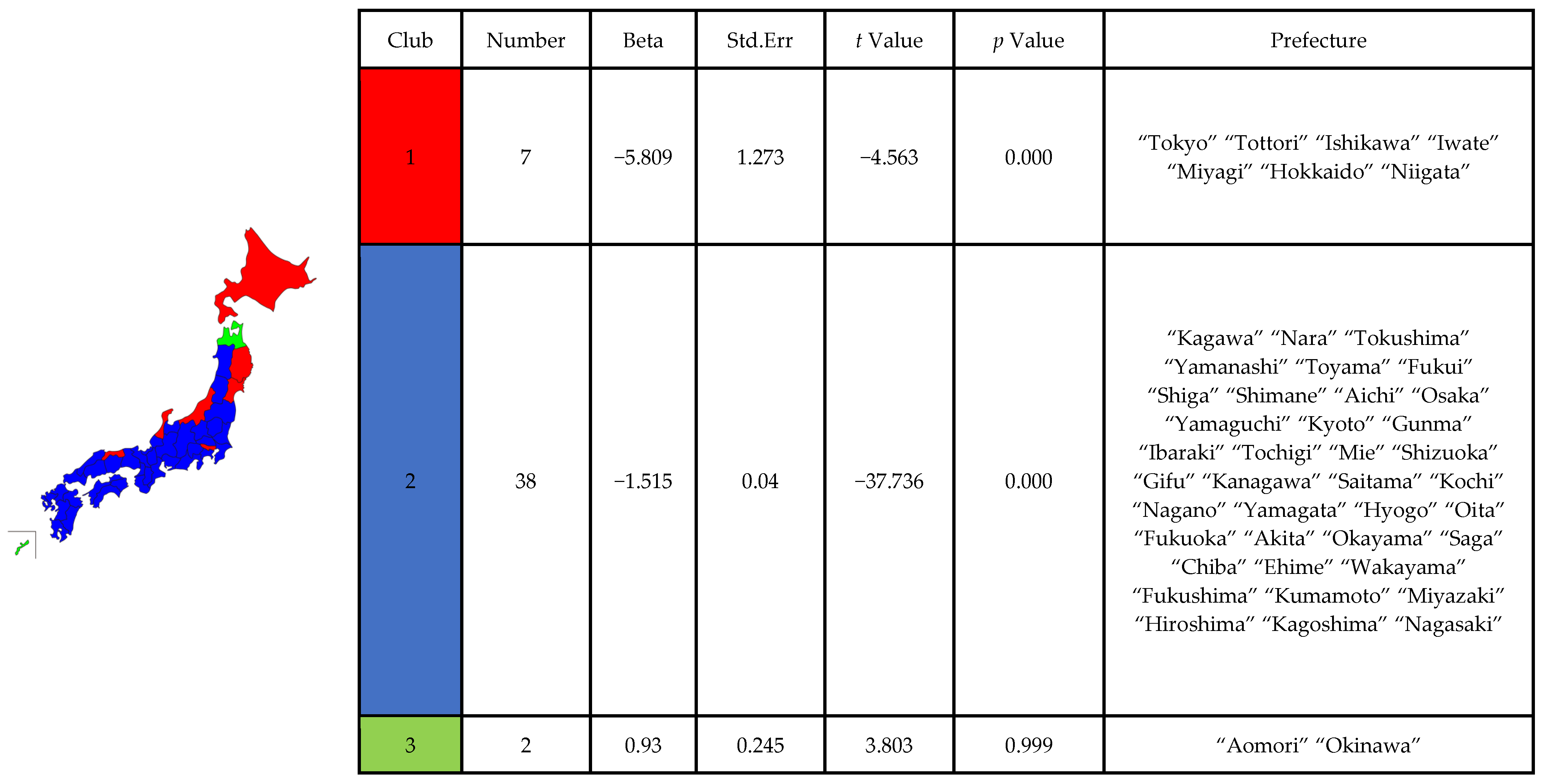Integrated Efficiency of Japan’s 47 Prefectures Incorporating Sustainability Factors
Abstract
:1. Introduction
2. Literature Review
3. Methodology and Data
3.1. Data Envelopment Analysis
3.1.1. CCR and BCC Models
3.1.2. Intermediate Approach
3.1.3. Super-Efficiency Model
3.2. Data
3.3. Club Convergence Analysis
4. Results and Discussion
4.1. DEA Results
4.2. Discussion on DEA Results
4.3. Club Convergence Results
4.4. Discussion on Club Convergence Results
5. Conclusions
Author Contributions
Funding
Data Availability Statement
Conflicts of Interest
References
- Otsuka, A. Analysis of productive efficiency in Japanese regional economies. Stud. Reg. Sci. 2014, 44, 453–465. [Google Scholar] [CrossRef]
- Regional Decarbonization Roadmap. Available online: https://www.cas.go.jp/jp/seisaku/datsutanso/pdf/20210609_chiiki_roadmap.pdf (accessed on 1 April 2024). (In Japanese).
- Stiglitz, J.E.; Sen, A.; Fitoussi, J.-P. Report by the Commission on the Measurement of Economic Performance and Social Progress. Available online: https://www.economie.gouv.fr/files/finances/presse/dossiers_de_presse/090914mesure_perf_eco_progres_social/synthese_ang.pdf (accessed on 1 April 2024).
- Wang, D.; Li, S.; Sueyoshi, T. DEA environmental assessment on U.S. industrial sectors: Investment for improvement in operational and environmental performance to attain corporate sustainability. Energy Econ. 2014, 45, 254–267. [Google Scholar] [CrossRef]
- Wang, D.D. Assessing road transport sustainability by combining environmental impacts and safety concerns. Transp. Res. D Transp. Environ. 2019, 77, 212–223. [Google Scholar] [CrossRef]
- Sueyoshi, T.; Goto, M. Environmental Assessment on Energy and Sustainability by Data Envelopment Analysis; John Wiley & Sons, Ltd.: Chichester, UK, 2018; pp. 1–699. [Google Scholar]
- Managi, S. Luenberger and Malmquist productivity indices in Japan, 1955–1995. Appl. Econ. Lett. 2003, 10, 581–584. [Google Scholar] [CrossRef]
- Nemoto, J.; Goto, M. Productive efficiency, scale economies and technical change: A new decomposition analysis of TFP applied to the Japanese prefectures. J. Jpn. Int. Econ. 2005, 19, 617–634. [Google Scholar] [CrossRef]
- Nakano, M.; Managi, S. Productivity analysis with CO2 emissions in Japan. Pac. Econ. Rev. 2010, 15, 708–718. [Google Scholar] [CrossRef]
- Hashimoto, A.; Fukuyama, H. Evaluation of prefectural productivity considering greenhouse gas emissions. Trans. Oper. Res. Soc. Jpn. 2017, 60, 1–19. (In Japanese) [Google Scholar] [CrossRef]
- Fukuyama, H.; Hashimoto, A.; Weber, W.L. Environmental efficiency, energy efficiency and aggregate well-being of Japanese prefectures. J. Clean. Prod. 2020, 271, 122810. [Google Scholar] [CrossRef]
- Goto, M.; Mohammed Atris, A.; Otsuka, A. Productivity change and decomposition analysis of Japanese regional economies. Reg. Stud. 2018, 52, 1537–1547. [Google Scholar] [CrossRef]
- Honma, S.; Hu, J.-L. Total-factor energy efficiency of regions in Japan. Energy Policy 2008, 36, 821–833. [Google Scholar] [CrossRef]
- Barro, R.J.; Sala-i-Martin, X. Regional cohesion: Evidence and theories of regional growth and convergence. Eur. Econ. Rev. 1995, 40, 1325–1352. [Google Scholar]
- Kawagoe, M. Regional dynamics in Japan: A reexamination of Barro regressions. J. Jpn. Int. Econ. 1999, 13, 61–72. [Google Scholar] [CrossRef]
- Togo, K. Productivity convergence in Japan’s manufacturing industries. Econ. Lett. 2002, 75, 61–67. [Google Scholar] [CrossRef]
- Otsuka, A.; Goto, M. Total factor productivity and the convergence of disparities in Japanese regions. Ann. Regional Sci. 2016, 56, 419–432. [Google Scholar] [CrossRef]
- Jobert, T.; Karanfil, F.; Tykhonenko, A. Convergence of per capita carbon dioxide emissions in the EU: Legend or reality? Energy Econ. 2010, 32, 1364–1373. [Google Scholar] [CrossRef]
- Kounetas, K.; Zervopoulos, P.D. A cross-country evaluation of environmental performance: Is there a convergence-divergence pattern in technology gaps? Eur. J. Oper. Res. 2019, 273, 1136–1148. [Google Scholar] [CrossRef]
- Sueyoshi, T.; Wang, D. Rank dynamics and club convergence of sustainable development for countries around the world. J. Clean. Prod. 2020, 250, 119480. [Google Scholar] [CrossRef]
- Charnes, A.; Cooper, W.W.; Rhodes, E. Measuring the efficiency of decision making units. Eur. J. Oper. Res. 1978, 2, 429–444. [Google Scholar] [CrossRef]
- Banker, R.D.; Charnes, A.; Cooper, W.W. Some models for estimating technical and scale inefficiencies in data envelopment analysis. Manag. Sci. 1984, 30, 1078–1092. [Google Scholar] [CrossRef]
- Chung, Y.H.; Fare, R.; Grosskopf, S. Productivity and undesirable outputs: A directional distance function approach. J. Environ. Manag. 1997, 51, 229–240. [Google Scholar] [CrossRef]
- Chambers, R.G.; Chung, Y.; Färe, R. Benefit and distance functions. J. Econ. Theory 1996, 70, 407–419. [Google Scholar] [CrossRef]
- Sueyoshi, T.; Yuan, Y. Social sustainability measured by intermediate approach for DEA environmental assessment: Chinese regional planning for economic development and pollution prevention. Energy Econ. 2017, 66, 154–166. [Google Scholar] [CrossRef]
- Tomikawa, T.; Goto, M. Efficiency assessment of Japanese National Railways before and after privatization and divestiture using data envelopment analysis. Transp. Policy 2022, 118, 44–55. [Google Scholar] [CrossRef]
- Andersen, P.; Petersen, N.C. A procedure for ranking efficient units in data envelopment analysis. Manag. Sci. 1993, 39, 1261–1264. [Google Scholar] [CrossRef]
- Tone, K. A slacks-based measure of super-efficiency in data envelopment analysis. Eur. J. Oper. Res. 2002, 143, 32–41. [Google Scholar] [CrossRef]
- Zhang, X.; Sun, H.; Wang, T. Impact of financial inclusion on the efficiency of carbon emissions: Evidence from 30 provinces in China. Energies 2022, 15, 7316. [Google Scholar] [CrossRef]
- Chu, X.; Jin, Y.; Wang, X.; Wang, X.; Song, X. The evolution of the spatial-temporal differences of municipal solid waste carbon emission efficiency in China. Energies 2022, 15, 3987. [Google Scholar] [CrossRef]
- De Salvo, M.; Signorello, G.; Cucuzza, G.; Begalli, D.; Agnoli, L. Estimating preferences for controlling beach erosion in Sicily. Aestimum 2018, 72, 27–38. [Google Scholar]
- De Salvo, M.; Notaro, S.; Cucuzza, G.; Giuffrida, L.; Signorello, G. Protecting the local landscape or reducing greenhouse gas emissions? A study on social acceptance and preferences towards the installation of a wind farm. Sustainability 2021, 13, 12755. [Google Scholar] [CrossRef]
- Phillips, P.; Sul, D. Transition modeling and econometric convergence tests. Econometrica 2007, 75, 1771–1855. [Google Scholar] [CrossRef]
- Sichera, R.; Pizzuto, P. Convergence clubs: A package for performing the Phillips and Sul’s club convergence clustering procedure. R J. 2019, 11, 142–151. [Google Scholar] [CrossRef]
- Yamao, N.; Ohkawara, T. The regional allocation of public investment: Efficiency or equity? J. Reg. Sci. 2000, 40, 205–229. [Google Scholar] [CrossRef]








| Element | Data Used | Unit | Source |
|---|---|---|---|
| Labor | Number of workers in the prefecture | Number of persons | Prefectural Accounts, Cabinet Office, Government of Japan |
| Energy | Total energy consumption | TJ (Terajoule) | Statistical Survey of Energy Consumption by Prefecture, Agency for Natural Resources and Energy, Ministry of Economy, Trade and Industry |
| Social capital stock | Total social capital stock | Millions of Yen | Cabinet Office, Government of Japan Social Capital Stock Estimates |
| Private capital stock | R-JIP net capital stock | Millions of Yen | RIETI (Research Institute of Economy, Trade and Industry) Industrial Productivity by Prefecture (R-JIP) database |
| GRP | Gross prefectural product | Millions of Yen | Prefectural Accounts, Cabinet Office, Government of Japan |
| CO2 emissions | CO2 emissions | Ton CO2 | Ministry of the Environment Greenhouse Gas Emissions Calculation, Reporting and Publication System |
| Happiness index | Happiness index | – | Created by the author |
| 1st Layer | 2nd Layer | 3rd Layer |
|---|---|---|
| Comprehensive Subjective Satisfaction | 1. Households and assets | ① Disposable income |
| ② Financial assets balance | ||
| ③ Lifetime wage | ||
| 2. Employment environment and wages | ① Unemployment rate/job openings | |
| ② Number of full-time and involuntary part-time jobs | ||
| ③ Prescribed salary amount/minimum wage | ||
| 3. Housing | ① Gross floor area | |
| ② Expenses for rent of space, land, etc. | ||
| ③ House ownership rate | ||
| 4. Work and life | ① Actual working hours | |
| ② Percentage of employees working long hours (49 h or more per week) | ||
| ③ Sub-yearly percentage of employees taking paid leave | ||
| 5. Health condition | ① Average life expectancy/healthy life expectancy | |
| ② Percentage of persons with strongly suspected diabetes and number of deaths due to lifestyle-related diseases | ||
| ③ Percentage of those who have an exercise habit | ||
| 6. Educational standards and environment | ① University attendance rate | |
| ② International rankings of learning achievement | ||
| ③ Number of social enrolment | ||
| 7. Social connections | ① Volunteer action rate | |
| ② Total individual donations | ||
| ③ Time of dating/relationship | ||
| 8. Natural environment such as air and water | ① Percentage of achievement of environmental standards for PM2.5 and water quality | |
| ② Percentage of noise meeting environmental standards | ||
| ③ Forest coverage, urban park area per capita | ||
| 9. Personal safety | ① Number of criminal offenses | |
| ② Number of persons killed in traffic accidents | ||
| ③ Deaths and missing persons due to natural disasters | ||
| 10. Ease of raising children | ① Number of children on waiting list for childcare centers | |
| ② Percentage of employees taking childcare leave | ||
| ③ Total cost of study for children (kindergarten through high school) | ||
| 11. Ease of caring and being cared for | ① Percentage of recipients of long-term care insurance services | |
| ② Percentage of establishments with nursing care leave system provisions/nursing care turnover rate | ||
| ③ Nursing and caregiving hours |
| Field | Data Used | Reference Factors for Comprehensive Subjective Satisfaction | Unit | +/− | Source |
|---|---|---|---|---|---|
| 1. Households and assets | ① Disposable income (average of working households) | Disposable income | Yen | + | Social and Demographic Systems L |
| ② Deposits and savings (average of working households) | Financial assets balance | Yen | + | Social and Demographic Systems L | |
| 2. Employment environment and wages | ① Fully unemployed rate | Unemployment rate/job openings | Person | − | Social and Demographic Systems F |
| ② Prescribed salary amount (total average) | Prescribed salary amount/minimum wage | Thousands Yen | + | Social and Demographic Systems F | |
| 3. Housing | ① Gross floor area per residence | Gross floor area | m2 | + | Social and Demographic Systems H |
| ② Rent per 3.3 m2 | Expenses for rent of space, land, etc. | Yen | − | Social and Demographic Systems H | |
| 4. Work and life | ① Overtime work hours (total average) | Percentage of employees working long hours (49 h or more per week) | Hour | − | Social and Demographic Systems F |
| ② Percentage of employees taking paid leave | Sub-yearly percentage of employees taking paid leave | % | + | Social Survey of Living Standards | |
| 5. Health condition | ① Healthy life expectancy (total average) | Average life expectancy/healthy life expectancy | Age | + | Social and Demographic Systems I |
| ② Total average hours per sports actor per week | Percentage of those who have an exercise habit | Minute | + | Social Survey of Living Standards | |
| 6. Educational standards and environment | ① Academic status survey results (elementary school students) | International rankings of learning achievement | Score | + | National Survey of Academic Performance and Learning |
| ② Academic status survey results (junior high school students) | International rankings of learning achievement | Score | + | National Survey of Academic Performance and Learning | |
| 7. Social connections | ① Total average hours of volunteer and social participation activities | Volunteer action rate | Minute | + | Social Survey of Living Standards |
| ② Donation total | Total individual donations | Yen | + | Red Feather Community Chest | |
| 8. Natural environment such as air and water | ① Percentage of forest area | Forest coverage, urban park area per capita | % | + | Social and Demographic Systems B |
| ② Percentage of nature park area | Forest coverage, urban park area per capita | % | + | Social and Demographic Systems B | |
| 9. Personal safety | ① Amount of damage caused by disasters | Deaths and missing persons due to natural disasters | Millions of Yen | − | Social and Demographic Systems K |
| ② Number of persons killed in traffic accidents | Number of persons killed in traffic accidents | Person | − | Social and Demographic Systems K | |
| 10. Ease of raising children | ① Percentage of employees taking childcare leave (male) | Percentage of employees taking childcare leave | % | + | Basic Survey of Employment Structure |
| ② Percentage of employees taking childcare leave (female) | Percentage of employees taking childcare leave | % | + | Basic Survey of Employment Structure | |
| 11. Ease of caring and being cared for | ① Amount of nursing care benefits paid per case | Percentage of recipients of long-term care insurance services | Thousands Yen | + | Social and Demographic Systems J |
| ② Nursing and caregiving hours | Nursing and caregiving hours | Minute | − | Social Survey of Living Standards |
| Prefecture | Average | Rank | Prefecture | Average | Rank | Prefecture | Average | Rank |
|---|---|---|---|---|---|---|---|---|
| Hokkaido | 0.3279 | 40 | Ishikawa | 0.8362 | 3 | Okayama | 0.4243 | 31 |
| Aomori | 0.2754 | 43 | Fukui | 0.9268 | 2 | Hiroshima | 0.4748 | 27 |
| Iwate | 0.4036 | 34 | Yamanashi | 0.5558 | 16 | Yamaguchi | 0.4988 | 22 |
| Miyagi | 0.2873 | 42 | Nagano | 0.5939 | 9 | Tokushima | 0.4714 | 29 |
| Akita | 0.6559 | 7 | Gifu | 0.5671 | 12 | Kagawa | 0.5339 | 18 |
| Yamagata | 0.5363 | 17 | Shizuoka | 0.6573 | 6 | Ehime | 0.4121 | 32 |
| Fukushima | 0.4886 | 24 | Aichi | 0.4764 | 26 | Kochi | 0.3644 | 38 |
| Ibaraki | 0.5047 | 21 | Mie | 0.5730 | 11 | Fukuoka | 0.1909 | 45 |
| Tochigi | 0.5205 | 19 | Shiga | 0.5605 | 14 | Saga | 0.5138 | 20 |
| Gunma | 0.4253 | 30 | Kyoto | 0.3832 | 36 | Nagasaki | 0.3174 | 41 |
| Saitama | 0.4883 | 25 | Osaka | 0.0499 | 47 | Kumamoto | 0.3855 | 35 |
| Chiba | 0.4721 | 28 | Hyogo | 0.3706 | 37 | Oita | 0.5569 | 15 |
| Tokyo | 0.6600 | 5 | Nara | 0.4923 | 23 | Miyazaki | 0.4118 | 33 |
| Kanagawa | 0.5662 | 13 | Wakayama | 0.2451 | 44 | Kagoshima | 0.3321 | 39 |
| Niigata | 0.5897 | 10 | Tottori | 0.6211 | 8 | Okinawa | 0.1041 | 46 |
| Toyama | 0.9896 | 1 | Shimane | 0.7330 | 4 |
| Prefecture | Analysis A Ave. (2007–2018) | Analysis B Ave. (2007–2018) | Analysis C Ave. (2007–2018) | Prefecture | Analysis A Ave. (2007–2018) | Analysis B Ave. (2007–2018) | Analysis C Ave. (2007–2018) |
|---|---|---|---|---|---|---|---|
| Hokkaido | 0.6084 | 0.6084 | 0.6088 | Shiga | 0.9998 | 0.9998 | 1.0123 |
| Aomori | 0.5243 | 0.5310 | 0.5376 | Kyoto | 0.9492 | 0.9537 | 0.9541 |
| Iwate | 0.7567 | 0.7666 | 0.7707 | Osaka | 0.9580 | 0.9580 | 0.9580 |
| Miyagi | 0.7031 | 0.7048 | 0.7057 | Hyogo | 0.7899 | 0.7899 | 0.7936 |
| Akita | 0.6413 | 0.6552 | 0.8097 | Nara | 0.8813 | 0.8967 | 1.1141 |
| Yamagata | 0.8161 | 0.8334 | 0.8665 | Wakayama | 0.8708 | 0.8708 | 0.8708 |
| Fukushima | 0.7368 | 0.7368 | 0.7481 | Tottori | 0.9959 | 0.9964 | 1.6124 |
| Ibaraki | 0.8459 | 0.8459 | 0.8500 | Shimane | 0.6623 | 0.7041 | 1.0661 |
| Tochigi | 0.8769 | 0.8769 | 0.8906 | Okayama | 0.8027 | 0.8027 | 0.8067 |
| Gunma | 0.8740 | 0.8748 | 0.8763 | Hiroshima | 0.7308 | 0.7308 | 0.7421 |
| Saitama | 0.8926 | 0.8926 | 0.8958 | Yamaguchi | 0.9107 | 0.9107 | 0.9173 |
| Chiba | 0.7993 | 0.7993 | 0.8026 | Tokushima | 1.1116 | 1.1116 | 1.1129 |
| Tokyo | 1.6334 | 1.6339 | 1.6570 | Kagawa | 1.3931 | 1.3931 | 1.3993 |
| Kanagawa | 0.8901 | 0.8901 | 0.8942 | Ehime | 0.7769 | 0.7769 | 0.7897 |
| Niigata | 0.5817 | 0.5819 | 0.6054 | Kochi | 1.0232 | 1.0232 | 1.0247 |
| Toyama | 0.8487 | 0.8488 | 1.1104 | Fukuoka | 0.8155 | 0.8155 | 0.8155 |
| Ishikawa | 0.6981 | 0.7467 | 1.0594 | Saga | 0.6617 | 0.6983 | 0.7648 |
| Fukui | 0.9154 | 0.9165 | 1.1607 | Nagasaki | 0.7569 | 0.7665 | 0.7687 |
| Yamanashi | 0.9581 | 1.0044 | 1.1266 | Kumamoto | 0.7710 | 0.7809 | 0.7907 |
| Nagano | 0.7892 | 0.7994 | 0.8478 | Oita | 0.7786 | 0.7786 | 0.8164 |
| Gifu | 0.9074 | 0.9074 | 0.9254 | Miyazaki | 0.7183 | 0.7305 | 0.7454 |
| Shizuoka | 0.9183 | 0.9183 | 0.9334 | Kagoshima | 0.7138 | 0.7326 | 0.7653 |
| Aichi | 0.9332 | 0.9332 | 0.9338 | Okinawa | 0.4431 | 0.4760 | 0.4847 |
| Mie | 0.8593 | 0.8593 | 0.8730 |
| Beta | Std.Err | t-Value | p-Value |
|---|---|---|---|
| −1.420 | 0.022 | −64.260 | 0.000 |
| Beta | Std.Err | t-Value | p-Value |
|---|---|---|---|
| −1.749 | 0.049 | −35.576 | 0.000 |
Disclaimer/Publisher’s Note: The statements, opinions and data contained in all publications are solely those of the individual author(s) and contributor(s) and not of MDPI and/or the editor(s). MDPI and/or the editor(s) disclaim responsibility for any injury to people or property resulting from any ideas, methods, instructions or products referred to in the content. |
© 2024 by the authors. Licensee MDPI, Basel, Switzerland. This article is an open access article distributed under the terms and conditions of the Creative Commons Attribution (CC BY) license (https://creativecommons.org/licenses/by/4.0/).
Share and Cite
Ishida, R.; Goto, M. Integrated Efficiency of Japan’s 47 Prefectures Incorporating Sustainability Factors. Energies 2024, 17, 1910. https://doi.org/10.3390/en17081910
Ishida R, Goto M. Integrated Efficiency of Japan’s 47 Prefectures Incorporating Sustainability Factors. Energies. 2024; 17(8):1910. https://doi.org/10.3390/en17081910
Chicago/Turabian StyleIshida, Ryo, and Mika Goto. 2024. "Integrated Efficiency of Japan’s 47 Prefectures Incorporating Sustainability Factors" Energies 17, no. 8: 1910. https://doi.org/10.3390/en17081910
APA StyleIshida, R., & Goto, M. (2024). Integrated Efficiency of Japan’s 47 Prefectures Incorporating Sustainability Factors. Energies, 17(8), 1910. https://doi.org/10.3390/en17081910







